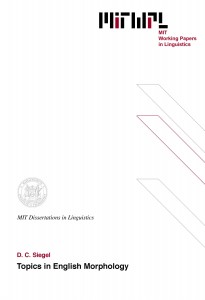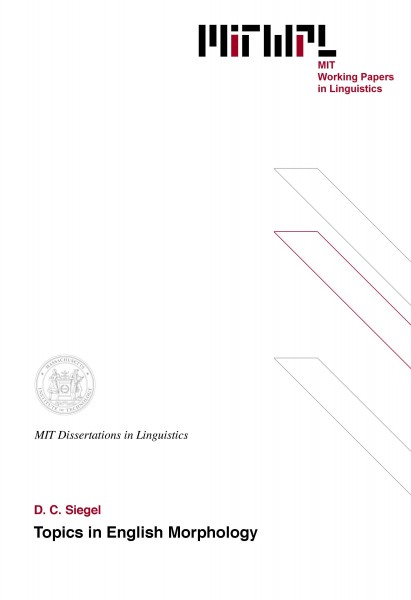Topics in English Morphology
D. C. Siegel, 1974
This thesis concerns aspects of English inflectional and derivational morphology.
In Chapter 1, a theory of English case is developed. The morphology of genitive pronouns is investigated. It is shown that the genitive feature originates in the determiner. A phrase structure rule which expands N'''' as N'''CASE is motivated. The structure-dependent rules which realize CASE are formulated and their ordering is investigated. The empirical consequences of enriching the structure of noun phrases is discussed. A condition on N''', the CASE Condition, is proposed and its consequences are discussed. The surface rules which incorporate the genitive feature into nouns and pronouns are formulated.
In Chapter 2, some fundamental issues in derivational morphology are investigated. The nature and distribution of the boundaries are investigated. The nature and distribution of the boundaries which play a role in lexical word derivation are discussed. It is demonstrated that English affixes fall into two classes: those which are introduced with the + boundary (Class I affixes) and those which are introduced with the # boundary (Class II affixes). The application of the rules of primary stress assignment and stress subordination to lexically derived words is considered. The ways in which Class I and Class II affix-derived words differ are discussed. A schema of lexical organization which accounts for these differences is proposed. This schema obviates the need for global affixation conditions and constrains the generative capacity of the lexicon.
Thesis supervisor: Morris Halle
Title: Professor of Modern Languages and Linguistics
Table of Contents
Chapter 1 A Theory of English Case 28
1 The morphology of English genitive pronouns 28
1.1 The strong and weak forms of English genitive pronouns 28
1.2 The distribution of the strong and weak forms 29
1.3 Genitive spell-out on pronouns 34
1.4 Justification of the determiner source for the genitive
feature 35
1.4.1 Evidence that genitive pronouns are not subjects
or objects 36
1.4.2 One as the missing subject or object 45
1.5 Justification for not using syntactic dependency to predict
the distribution of the strong and weak forms 49
1.6 Reformulation of the genitive pronoun spell-out rule 54
2 The representation of CASE in phrase structure 55
2.1 Evidence that the distribution of the genitive feature
cannot be stated at the surface 57
2.2 N"""" 60
2.3 Revision of the phrase structure rules to incorporate N"""" 62
3 CASE-realization 63
3.1 Genitive CASE-realization 63
3.1.1 The rule"s application in noun phrases and
derived nominals 64
3.1.2 The rule"s application in verbal gerunds 64
3.2 Nominative and oblique CASE-realization 71
4 Formulations of genitive movement, NP-preposing, and agent-
postposing 73
5 Empirical consequences of the theory of CASE 78
5.1 Two types of movement rules 78
5.2 The CASE condition 79
5.3 Further remarks 80
6 Surface rules 85
6.1 Genitive incorporation 86
6.2 Genitive distribution 90
6.3 Genitive spell-out on nouns 94
7 Epilogue 98
Footnotes 100
Chapter 2 Basic Issues in Derivational Morphology 101
1 Introduction 101
2 The lexical representation of formatives 104
2.1 Stems 104
2.2 Prefixes 105
2.3 Suffixes 107
2.4 Underived words 109
2.5 Derived words 110
3 Two classes of affixes 111
3.1 Two classes of suffixes 111
3.1.1 Class I suffixes 111
3.1.2 Class II suffixes 112
3.2 Two classes of prefixes 114
3.2.1 Class I prefixes 115
3.2.2 Class II prefixes 130
4 The structure of the lexicon 148
4.1 Consequences of (36) 154
4.2 Sample derivations 155
4.2.1 Class I affixes 156
4.2.2 Class II affixes 160
5 Further empirical consequences of the proposed structure of the
lexicon 162
5.1 Elimination of global constraints on suffixation 163
5.2 The stacking-up of Class I and Class II affixes 182
Footnotes 189

